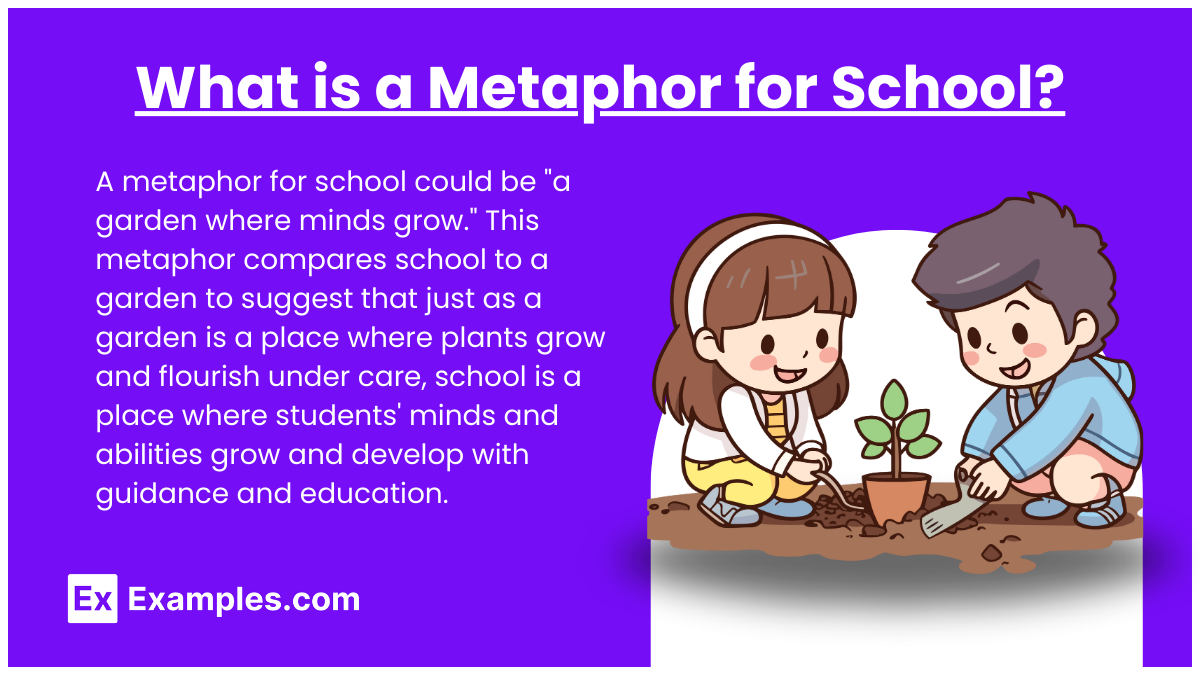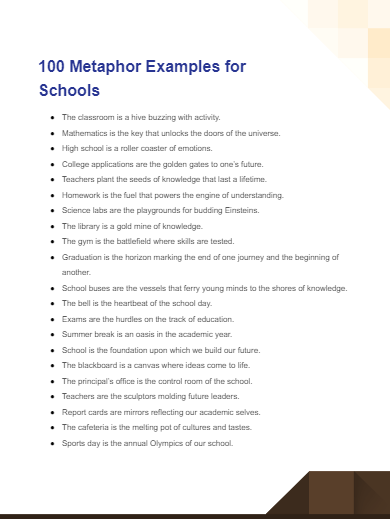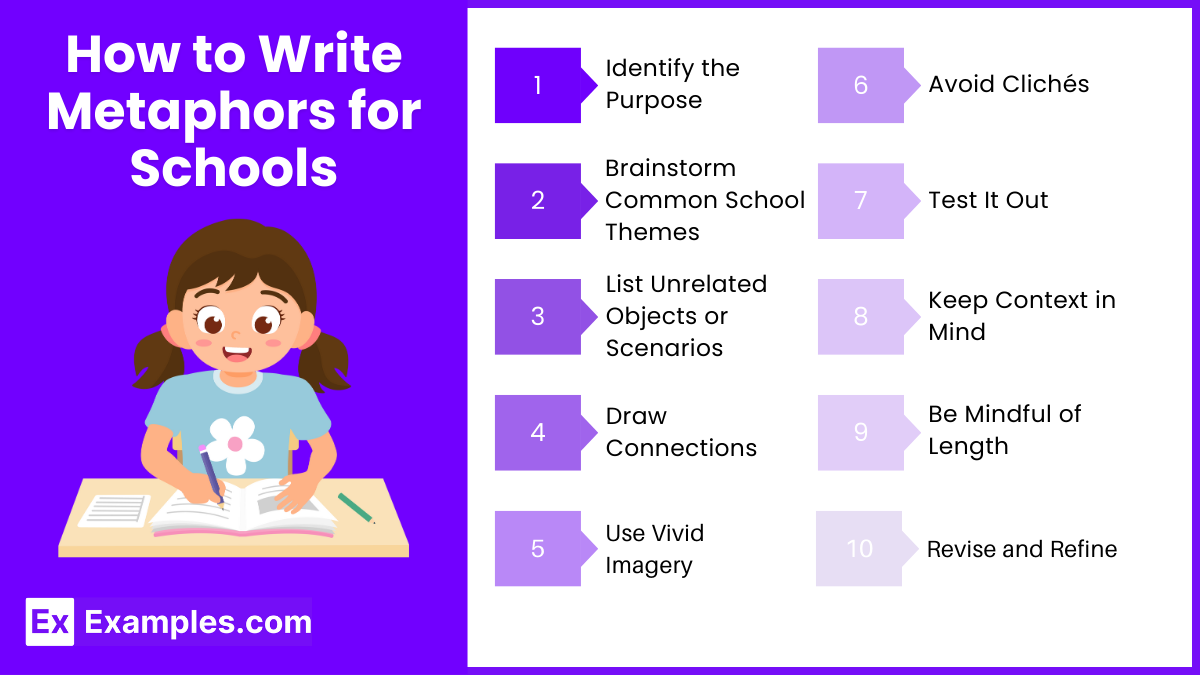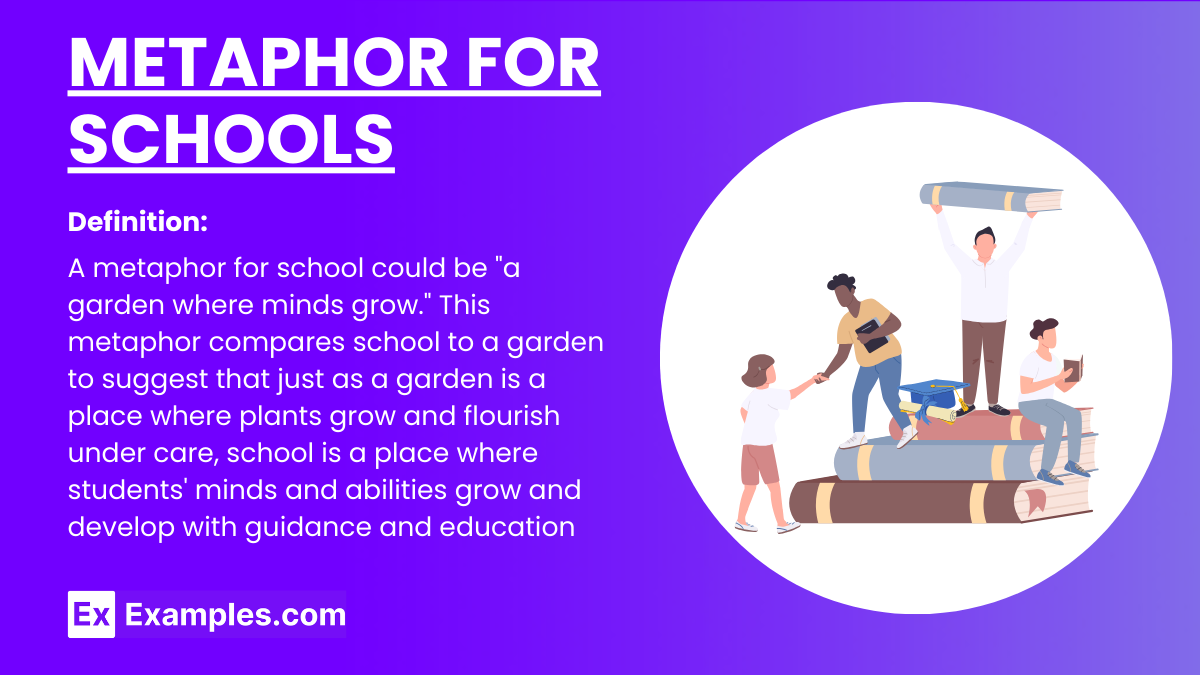99+ Metaphor for Schools Examples
Delving into the world of academia, the school setting provides a rich tapestry for metaphorical expressions. From the early years of molding young minds to the triumphs of graduation, schools symbolize growth, challenges, and transformations. Our guide on ‘Metaphor Examples for Schools’ not only showcases some of the most evocative metaphors but also offers insights on how to pen them. Whether you’re a writer, teacher, or student, these metaphors and tips will enrich your linguistic arsenal and understanding of the educational journey.
What is a Metaphor for School?

100 Metaphor Examples for Schools

- The classroom is a hive buzzing with activity.
- Mathematics is the key that unlocks the doors of the universe.
- High school is a roller coaster of emotions.
- College applications are the golden gates to one’s future.
- Teachers plant the seeds of knowledge that last a lifetime.
- Homework is the fuel that powers the engine of understanding.
- Science labs are the playgrounds for budding Einsteins.
- The library is a gold mine of knowledge.
- The gym is the battlefield where skills are tested.
- Graduation is the horizon marking the end of one journey and the beginning of another.
- School buses are the vessels that ferry young minds to the shores of knowledge.
- The bell is the heartbeat of the school day.
- Exams are the hurdles on the track of education.
- Summer break is an oasis in the academic year.
- School is the foundation upon which we build our future.
- The blackboard is a canvas where ideas come to life.
- The principal’s office is the control room of the school.
- Teachers are the sculptors molding future leaders.
- Report cards are mirrors reflecting our academic selves.
- The cafeteria is the melting pot of cultures and tastes.
- Sports day is the annual Olympics of our school.
- Each lesson is a step on the ladder of enlightenment.
- Kindergarten is the garden where young minds blossom.
- Schools are the crucibles where character is forged.
- The teacher’s desk is the command center of the classroom.
- The school anthem is the heartbeat of our collective spirit.
- Revision is the polish that makes knowledge shine.
- A good teacher is a lighthouse guiding students through storms of confusion.
- Field trips are windows to the world outside the classroom.
- The school bell heralds new beginnings and poignant endings.
- The student council is the government of the young republic.
- Sports coaches are the generals training their athletic armies.
- The school year is a marathon, with each term a milestone.
- A new school is an uncharted island of opportunities.
- School uniforms are the armor we wear to battle every academic challenge.
- Debate club is the courtroom of young orators.
- The school courtyard is the pulse of student life.
- History lessons are time machines into the past.
- Music class is the symphony of soulful expressions.
- Art rooms are the nurseries of creativity.
- The school’s mission statement is its North Star.
- Language classes are passports to foreign lands.
- The annual play is the Broadway of school life.
- Morning assembly is the daily meditation of the school.
- School reunions are time capsules opened after years.
- Textbooks are the silent mentors of our academic journey.
- The staff room is the backstage of the school’s daily performance.
- The school’s crest is its badge of honor.
- Exams are the thermometers measuring knowledge.
- Scholarships are the golden tickets to dreams.
- Detention is the short-term prison of school life.
- Teachers’ feedback is the GPS for academic improvement.
- Parent-teacher meetings are the bridges connecting home and school.
- A school’s reputation is its shadow, ever-present.
- Clubs and societies are the laboratories of hobbies and interests.
- School photos are the frozen moments in the river of time.
- The school yearbook is the archive of fleeting moments.
- Labs are the kitchens cooking up experiments.
- The school gate is the threshold between childhood and the world.
- Lockers are the personal vaults of secrets and memories.
- The morning pledge is the daily mantra of allegiance.
- Tutors are the unsung heroes of academic success.
- School elections are the first taste of democracy in action.
- Sports meets are the arenas showcasing gladiatorial prowess.
- Night study sessions are the midnight lamps of determination.
- Boarding school is the cocoon of self-discovery.
- Morning recess is the oasis of relaxation.
- School magazines are the chronicles of yearly endeavors.
- Classroom discussions are the symposiums of young philosophers.
- Remedial classes are the hospitals healing academic wounds.
- School corridors echo with tales of yesteryears.
- The school’s motto is its unchanging creed.
- Practical exams are the real-world test drives of knowledge.
- Study groups are the think tanks of collective brains.
- Teachers are the compasses directing our academic journey.
- The school emblem is its silent war cry.
- The school choir is the melody of unity.
- Annual functions are the festivals of achievements.
- School is the map charting the paths of countless futures.
- Mock tests are the rehearsals before the grand show.
- Project work is the canvas of collaborative efforts.
- Student achievements are the jewels in the school’s crown.
- Language labs are the crossroads of cultures.
- The school’s vision is its guiding star.
- School oaths are the pledges of honor and duty.
- Class leaders are the captains steering their classroom ships.
- The playground is the sandbox of dreams and aspirations.
- The computer lab is the digital universe in a room.
- The notice board is the daily newspaper of the school.
- Exams are the litmus tests of comprehension.
- The school mascot is the symbol of pride and unity.
- Student diaries are the autobiographies of academic lives.
- Holiday homework is the bridge between school years.
- Parent interactions are the town hall meetings of the school.
- The morning prayer is the spiritual start to academic endeavors.
- Career guidance sessions are the compasses for future paths.
- Scholar badges are the medals of academic valor.
- School trips are the adventures beyond classroom walls.
- School is the chisel shaping raw talent into masterpieces.
- Annual reports are the report cards of the institution itself
Metaphor Examples for Learning
Delving into the intricacies of learning, we often search for ways to represent the transformation and evolution it brings. These simple metaphors capture the essence and beauty of acquiring knowledge.
- Learning is a puzzle, each piece a new skill or knowledge.
- Absorbing knowledge is like a sponge soaking up water.
- Every lesson learned is a new feather in the cap of the mind.
- Acquiring skills is like weaving a tapestry of expertise.
- Learning is the bridge that spans the chasm of ignorance.
Metaphor Examples for Students
Students embody hope, potential, and ambition. They constantly adapt and change, brimming with the possibilities of tomorrow. These metaphors illuminate the journey and spirit of every student.
- Students are clay, malleable and ready to be shaped.
- Each student is a budding flower, waiting to bloom.
- A student’s mind is a blank canvas, eager for the artist’s stroke.
- They stand as saplings in the forest of knowledge, reaching for the sun.
- Students are stars, each one shining with its own light.
Metaphor Examples for Teachers
Teachers play a pivotal role in sculpting the minds of the future. With patience, dedication, and care, they transform the educational landscape. These metaphors for teaching pay homage to their invaluable contribution.
- A teacher is a gardener, nurturing the seeds of tomorrow.
- They are the architects, designing the structures of understanding.
- In the orchestra of education, teachers are the conductors.
- A teacher is a lighthouse, guiding ships safely to shore.
- They are the blacksmiths, tempering raw metal into fine blades of intellect.
Funny Metaphor Examples for Schools
Schools can be a blend of joy, humor, and chaos. While they are pillars of education, they also bring out funny, light-hearted moments that everyone remembers. These metaphors add a humorous touch to school life.
- School is a zoo, each class a different exhibit.
- The cafeteria is the wild jungle of flavors and food fights.
- Homework is the gremlin that eats up free time.
- Exams are the sneaky ninjas testing our defenses.
- The school bell is the alarm clock nobody asked for.
Metaphors about First Day of School
The first day of school is a memorable rite of passage. It’s a mix of anxiety, excitement, and the start of a new chapter. These metaphors encapsulate the myriad of emotions felt on that special day.
- The first day is the maiden voyage into the ocean of academia.
- It’s the opening scene in the theater of the school year.
- The initial school day is the first brushstroke on the canvas of the term.
- It’s like turning the first page in the novel of a new academic year.
- The first day stands as the dawn of countless adventures and stories
How to Write Metaphors for Schools

- Identify the Purpose: Before creating a metaphor, understand why you need it. Are you trying to evoke a certain emotion, explain a complex idea, or add humor?
- Brainstorm Common School Themes: Think of the universal experiences or objects in schools: homework, classes, students, teachers, exams, recess, etc.
- List Unrelated Objects or Scenarios: Think outside of the educational realm. This could include nature (forests, oceans, stars), daily life (traffic, gardening, cooking), or any other domain.
- Draw Connections: Try to link the school theme with the unrelated object. For instance, how is a teacher similar to a gardener? Both nurture growth. Thus, “A teacher is like a gardener, tending to young minds, helping them bloom.”
- Use Vivid Imagery: Make your metaphor more impactful by adding details. Instead of just saying “School is a journey,” you could elaborate with “School is a winding journey, with its steep hills of challenges and panoramic views of achievements.”
- Avoid Clichés: While “knowledge is power” is a valid metaphor, it’s been used frequently. Try to think of fresh, innovative comparisons.
- Test It Out: Share your metaphor with others. If they quickly understand and relate to it, you’re on the right track. If not, you might need to refine it for clarity.
- Keep Context in Mind: Ensure your metaphor is appropriate for the age group and cultural context. A metaphor that works well for college students might not resonate with elementary school kids.
- Be Mindful of Length: Metaphors are typically most effective when they’re concise. However, for certain narratives or poetic contexts, extended metaphors can be used.
- Revise and Refine: Like all writing, your first draft might not be perfect. Refine your metaphor, enhance its imagery, or simplify it if necessary.
Remember, the beauty of a metaphor lies in its ability to make readers or listeners see something familiar in a new light. With practice and observation, your ability to craft compelling metaphors for schools will only improve.
How to Implement Metaphors in Schools
Implementing metaphors in schools can enhance learning, making complex ideas more relatable and understandable for students. Here’s a step-by-step guide on how to effectively use metaphors in an educational setting:
- Start with Familiar Concepts: Begin by introducing metaphors that draw on students’ existing knowledge or daily life experiences. This ensures comprehension and lays a foundation for introducing more complex metaphors.
- Integrate in Curriculum: Align metaphors with the current topic of study. For instance, when teaching about the circulatory system, you might compare it to a city’s transportation system.
- Interactive Lessons: Organize activities where students can come up with their metaphors. This encourages creativity and a deeper understanding of the subject matter.
- Visual Aids: Use images, videos, or props to illustrate metaphors. Visual representations can make abstract concepts tangible and memorable.
- Discussion: Allow students to discuss and interpret metaphors. This helps them to grasp different perspectives and understand the layers of meaning.
- Incorporate in Assignments: Encourage students to use metaphors in their essays, stories, or projects. This not only enhances their writing skills but also deepens their understanding of the subject.
- Clarify Misunderstandings: Metaphors can sometimes lead to misconceptions. It’s essential to ensure that students understand the intended meaning and the limits of a metaphor.
- Use in Assessments: Create questions that require students to interpret or devise their metaphors. This tests their understanding and application of the concept.
- Extend to Real-life Situations: Encourage students to identify metaphors in daily life, be it in songs, movies, or books. This will help them recognize the pervasive nature of metaphors and their importance in communication.
- Review and Reflect: Regularly revisit and reflect on the metaphors introduced. Ask students which metaphors were most effective and why, fostering critical thinking.
- Diversify Sources: Incorporate metaphors from diverse cultures and languages. This introduces students to different ways of thinking and broadens their worldview.
- Stay Updated: As with any teaching method, it’s crucial to keep updating your metaphor bank. What was relevant a decade ago might not resonate with today’s students.
By implementing metaphors effectively in schools, educators can foster a richer, more engaging learning environment. It not only aids comprehension but also instills a love for language and its nuances in students.
Tips for School Metaphors
- Relatability is Key: Choose metaphors that students can easily connect with based on their age, interests, and experiences.
- Keep it Simple: Especially for younger students or those new to the concept of metaphors, it’s best to start with straightforward comparisons before delving into more complex ones.
- Encourage Creativity: Prompt students to come up with their metaphors. This fosters creativity and helps them internalize the concept.
- Use Multimedia: Visual and auditory aids, like videos or songs, can make a metaphor more impactful and memorable.
- Clarify the Differences: While metaphors can simplify concepts, they’re not perfect matches. Make sure students understand where the metaphor stops and the actual concept starts.
- Incorporate Diversity: Use metaphors from various cultures, backgrounds, and literature. It widens students’ perspectives and appreciation for different worldviews.
- Practice Makes Perfect: Regularly include metaphor exercises in lessons. Over time, students will become more adept at understanding and creating them.
- Feedback Loop: After presenting a metaphor, ensure there’s a discussion or Q&A session. This helps clarify any misunderstandings immediately.
- Update Regularly: Just as slang evolves, so do effective metaphors. What resonated with students a few years ago might not have the same impact today.
- Integrate with Literature: Use excerpts from books, poems, or speeches where metaphors are used effectively. Analyzing them in context deepens comprehension.
- Interactive Activities: Organize group activities or games that revolve around metaphors. For instance, a game where students match concepts with their metaphorical counterparts can be both fun and educational.
- Connect with Emotions: Metaphors that evoke emotion tend to be more impactful. Drawing comparisons with emotions like happiness, sadness, or excitement can make lessons resonate more.
FAQs
How can teachers effectively use metaphors?
Teachers can use metaphors to link new information with familiar concepts, enhancing student comprehension and engagement.
What is an example of a metaphor used in education?
A common educational metaphor is “the classroom is a beehive,” suggesting that students, like bees, are active and collaborative in learning.
Can metaphors in schools improve learning outcomes?
Yes, metaphors can improve learning by making abstract ideas more concrete and relatable, which can enhance understanding and retention.
Are there risks in using metaphors in educational settings?
Misused metaphors can confuse students if they are too abstract or culturally irrelevant, leading to misunderstandings.
How often should metaphors be used in teaching?
Metaphors should be used judiciously—enough to aid learning without overwhelming or confusing students with excessive or mixed metaphors.


